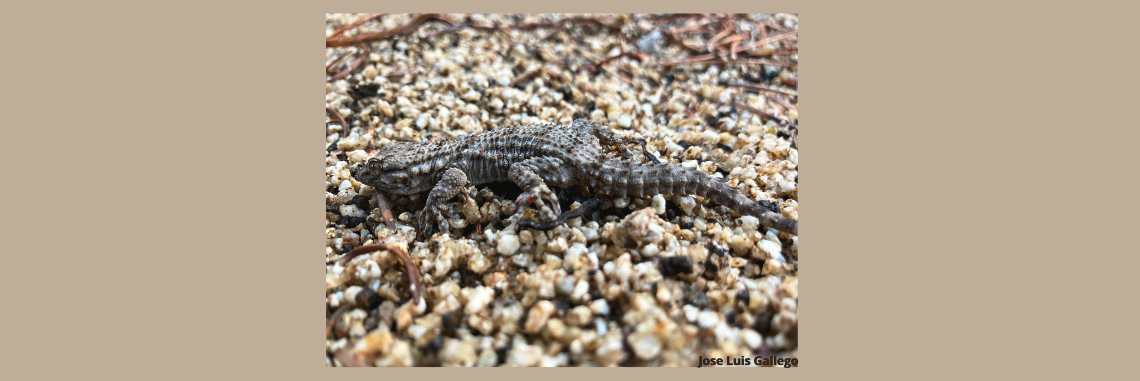The Wall Gecko, the Lizard of the Wine Cellar

By Jose Luis Gallego. environmental communicator (@ecogallego)
Since time immemorial, humans have felt a particular repulsion towards reptiles, an atavistic feeling that has prevented us from properly appreciating the countless benefits that their lovely company brings. Regardless of our natural aversion towards lizards and snakes, we know that reptiles play a crucial role in terms of controlling all sorts of pests in the fields. This is also true for the subject of this entry: the wall gecko, the little “dragon” famous for scaling vertical surfaces.
The common wall gecko, which herpetologists classify under the scientific name Tarentola mauritanica, is frequently spotted on walls and building facades in villages, where the reptile makes its home in sheds, farms, and wineries. As previously mentioned, despite its appearance and the many myths that paint the gecko in a negative light, this little saurian is not only harmless but actually beneficial to us humans.
A common wall gecko (photo: José Luis Gallego)
The erroneous belief that geckos seek out closets to eat clothes is both farfetched and unfair. In addition to not harming textiles, the lizard’s presence is in fact the best prevention against moths, which do indeed cause serious damage since they like to lay their eggs between the garments so their larvae can feed off them.
Well aware of this and many other benefits linked to their presence, people in rural areas are welcoming of the geckos in their midst, because they know that having them around the outside of the house, or even indoors, reduces the presence of insects.
Beyond the advantages of having geckos around, they are also fascinating creatures. Observing their anatomy and stealthy behaviour should not induce fear, but fascination for the biology and ethology of this curious nocturnal reptile.
About 15 centimetres from head to tail, the wall gecko has scaly rugged skin, either greyish brown or ash grey, which allows the lizard to perfectly mimic the colour and texture of the walls and ceilings and blend into its favourite hunting grounds.
A common wall gecko (photo: José Luis Gallego)
The exterior of village buildings and the interior of stables and sheds aren’t the only places geckos seek out: they also like to establish their territory in wine cellars, where they peacefully coexist with the people who work there, without causing any bother or affecting the slumber of the ageing wines. In fact, we might not even notice the gecko while the lights are off since they are likely half-hidden in a crack in the wall or corner of the ceiling.
Once the lights are turned on, the gecko will quietly move to the edge of the shadows, stopping just before the light on the walls would reveal its presence. It may stay here, completely still, for several minutes, waiting for the right moment to stage a surprise attack on its prey, which is attracted to the light: moths, daddy-longlegs, flies, mosquitoes, spiders, bugs, cockroaches…its menu is comprised of the least desirable visitors from our surrounding environment.
One of the most eye-catching features of the gecko’s curious appearance are its toes: long, thick, and globular. For years it was thought they contained suckers which allowed the gecko to vertically scale walls or even run upside down along ceilings, as though their toepads were stuck to the surface. However, we now know that this is not the case.
Scientists recently discovered that the secret behind the reptile’s astonishing ability to adhere to surfaces lies in the sophisticated nano-sized hairs that cover the creases of its toepads. Thanks to these filaments, which give the family of the common wall gecko its name (Phyllodactylidae) and sets it apart from common geckos (Gekkonidae), the reptile can move vertically across any surface, even windowpanes.
When observing these fascinating animals with the help of binoculars, the appearance of their enormous eyes is especially striking: gold coloured, as though filled with glitter, with a black vertical pupil that cuts across the eyeball from top to bottom, giving the gecko the look of an intergalactic creature.
Like all cold-blooded animals, the wall gecko will avoid contact with the outside world in winter, sheltering in its hideout without causing any trouble. During that time the reptile will shore up its strength to once again resume its incredible gravity-defying excursions along walls and ceilings with the onset of spring and the return of the light-seeking insects that comprise its diet.
